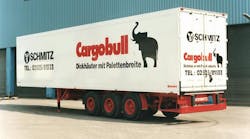Latest from Trailers
Tata launches Re.Wi.Re CV recycling program
Randon marks export milestone
Wabash expands parts network
Faymonville to build trailers in US
HORSTMAR, GERMANY. In 1892, blacksmith Heinrich Schmitz founded a company which would grow to become Europe’s leading manufacturer of semi-trailers, truck bodies and trailers for temperature-controlled freight, general cargo and bulk goods 125 years later.
Many strategic decisions have guided the transition from village forge to Europe’s leading trailer manufacturer. As a pioneer in the industry, the German company developed a comprehensive market and brand strategy early on and consistently established quality standards for its premium products spanning every level: from research and development, to production, and specialist services such as consulting, trailer telematics, financing, spare parts and used vehicles.
Since its founding, Schmitz Cargobull has grown to six plants in Germany and a plant each in Spain, Lithuania, Russia, China and Turkey. Group wide, the approximately 5,700 employees produced more than 57,000 vehicles in the 2016/17 business year and generated revenue of more than €2 billion ($2.4 billion). The Schmitz Cargobull headquarters is located in Horstmar, Münsterland in Germany.
Looking ahead, Schmitz Cargobull will focus on maintaining an international presence, further trailer development innovation, sustainable cost leadership, significant production flexibility and customer proximity, according to the company. The most recent example is the new plant in Adapazari, Turkey, where it is producing curtainsiders and box semi-trailers. The acquisition of a stake in South African manufacturer GRW marks the latest step into another market.
But it all began 125 years ago with the forge, which provided a number of different services in the early years including horseshoeing and repairs, and was also involved with agricultural machinery and ironware. Once freight transport became motorized in the 1920s, the company began manufacturing vehicles.
Josef and August Schmitz, the founder’s two eldest sons, took over the reins of the company in 1943, and under the motto “Schmitz-Anhänger vollenden jeden Zug” (“Schmitz trailers pull off every move”), the vehicle manufacturer made a name for itself throughout Germany in the 1950s and 1960s thanks to its varied range and patents, including the Schmitz tracking unit.
Trailers, semi-trailers, box bodies, tippers, tankers and tracking units also proved successful exports. In 1961, the approximately 300 employees built more than 300 vehicles. With the Altenberge production facility soon bursting at the seams, more plants were opened in Berlin (1967) and Vreden (1969).
The third generation, Dr. Heinz Schmitz and Peter Schmitz, took over at the helm in the early 1970s, with Schmitz-Anhänger employed more than 500 people for the first time in 1977, more than 1,000 in 1986 and more than 2,000 by 1992. Revenue increased tenfold between 1970 and 1990, as the company became Germany’s largest trailer manufacturer.
The market changed fundamentally when project business with oil-producing countries dried up, with German reunification in 1990, and the creation of the European Single Market in 1993. Top management decided to make a radical shift and focus on “growth through sacrifice.” With this in mind, from 1994 forward Schmitz-Anhänger only built trailers with platforms and tarpaulins, box bodies and tipper bodies or as container chassis.
Through process-driven industrial production, the lead time per vehicle was reduced from five weeks to five days and production hours from 190 to 35. The concept worked: 5,100 vehicles were manufactured in the 1992/93 business year and 17,000 a year by 1998/99.
The company became Schmitz Cargobull AG in late 1998.
Schmitz Cargobull’s numerous innovations and patents include:
- Schmitz tracking unit (1937), a self-tracking rear axle for three-axle trailers;
- Ferroplast (1977), robust sandwich panels with steel cover layers that are hot galvanized and coated on both sides, with a CFC-free, insulating polyurethane hard foam core;
- Double decker system in box semi-trailers (1982), a height-adjustable support beam system doubles the amount of pallet spaces;
- Rotos (1996), a perfectly harmonized running gear with air suspension, disc brakes, axle and various electronic safety components;
- Modulos (1999), a bolted chassis with galvanized steel and aluminum components;
- TrailerConnect (2004), a tried and tested trailer telematics system (more than 35,000 active units in trailers);
- S.CS Speed Curtain (2010), a convenient body for curtainsiders which can be opened and closed in just 35 seconds;
- Transport refrigeration unit (2012), developed in-house for temperature-controlled freight with digital data integration;
- S.CS Genios (2014), an enhancement of the Modulos chassis with cold-formed l-beams and crossbeams;
- S.KI Control (2014), a new safety technology via app for tipper trailers;
- S.KO COOL Complete (2016), a complete equipment package for transporting temperature-controlled freight, including data communication and control;
- V.KO Van Bodies (2017), a rounding off of the product range to the ‘last mile’ with van bodies (from 3.5 to 6 t).











